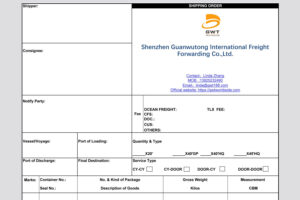您需要知道的所有關於船運提單的資訊
船運提單是一份重要文件。它也習慣性地被稱為 B/L。然而,很多托運人和收貨人都很難完全掌握其重要性和細節。本指南旨在闡明提單的作用和組成部分。

提單簡介
定義與目的
提單 (B/L) 是承運人簽發給托運人的法律文件,詳細列明所運貨物的類型、數量和目的地。提單可作為收據、所有權文件以及托運人與承運人之間的合約。
航運的重要性
提單對於確保貨物正確運輸並交付給正確的收貨人是非常重要的。在發生糾紛時,它也為雙方提供法律保護。
提單的主要組成部分
標頭資訊
發貨人和收貨人詳細資料:包括姓名、地址和聯絡資訊。
承運商資訊:運送公司的名稱和參考編號。
裝運詳情
貨品說明:詳細說明,包括數量、重量和尺寸。
包裝細節:使用的包裝類型(如板條箱、棧板)。
條款與細則
付款條款:指定付款方式和時間。
責任與說明:概述責任條款和任何特殊處理指示。
提單類型
直線 B/L
不可議付,用於特定收貨人的貨物。
訂單提單
可議價,並可經背書轉讓給協力廠商。
不記名提單
可透過交付轉讓,允許任何持有提單的人索償貨物。
常見錯誤與避免方法
不準確的細節
請仔細檢查所有資訊,以確保準確性,避免發貨延誤。
簽名遺失
確保所有必要方都簽署文件以確認其有效性。
如何有效使用提單
最佳實務
仔細檢閱:簽字前請務必審閱提單。
保留副本:保留副本以備記錄和任何可能的爭議。
合規提示
遵循法規:確保提單符合國際及當地航運法規。
總結
瞭解貨運提單對於確保順利、安全的貨物運輸至關重要。透過熟悉提單的組成部分和最佳實務,托運人和收貨人可以強化他們的託運流程,並避免常見的陷阱。
深圳廣梧桐(GWT)是一間 中國深圳國際貨運代理
































